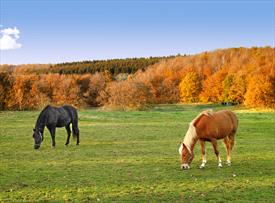Horses in fall pasture

If you want information on testing your pasture's quality, your state university's livestock extension office can direct you.
Equine Reflex Hypertonia is an abnormal gait caused by a neuromuscular condition. It is more commonly called “stringhalt” because the jerky, hesitant hyperflexion of the horse’s affected hind limb (or limbs) resembles a puppet being pulled by a string.
Your horse may walk with an exaggerated movement, holding the affected hind limb up unnaturally high before setting it down again. This odd gait is more obvious at the walk and less at the trot or canter. It may seem worse when your horse backs up, turns, or starts to walk after standing still.
What Causes Stringhalt?
Stringhalt is usually divided into two types: idiopathic (meaning the cause is not known) or acquired, also called Australian or plant/pasture associated.
Pasture-associated stringhalt: (PSH) Usually occurs when a horse has been kept on pasture during the late summer or early autumn when forage is not at its best quality or if toxic plants have been allowed to grow. Horses grazing in different pastures but in the same general area may develop it as the same toxic plants can grow across a wide area.
Certain types of toxic weeds found in Australia, New Zealand and the US have been associated with the condition. If overgrazing, drought, or other issues have left a pasture in poor nutritional condition, horses may eat plants that they otherwise wouldn’t touch. But horses are foragers, so it’s natural for them to sample things even if they are on a well-maintained pasture.
Plant-associated stringhalt is not very common in the United States.
Toxic Weeds Known to Cause Stringhalt
The weed Hypochaeris radicata, commonly called false dandelion, is native to Europe but also grows in several other countries (giving this type of stringhalt the name Australian or pasture-associated), including North and South America. This weed is hard to tell from genuine dandelions, which are not toxic.
The sweet pea plant, Lathyrus spp., also found in the US, is another suspected contributor to plant-associated stringhalt.
Plant-associated stringhalt usually clears up when the horse is removed from the source.
Australian (idiopathic) stringhalt: The cause is unknown, and with this type, the condition may be progressive and can be quite severe.
Treatment
If your horse’s condition is due to plant toxicity, it should clear up after the toxins are removed, and no further treatment is needed.
In the case of idiopathic stringhalt, your horse may recover on their own. In chronic cases, surgical intervention can be a possibility. The surgery involves the tendons and muscles of the affected limbs, and recovery and outcome depend on the severity of the condition and the horse’s overall health. Not all cases respond to surgery.
Other treatments may include thiamine, a vitamin B1 supplement, and phenytoin, an anticonvulsant.
Stringhalt is considered an unsoundness but it doesn’t necessarily mean your horse cannot have a fulfilling life. Signs may be sporadic and may even disappear during warm weather. However, the condition may make your horse unsuitable for some equestrian activities.
If you suspect your horse is showing signs of stringhalt, your veterinarian is your best resource for advice and treatment information.